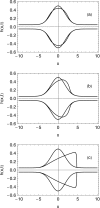A model of transluminal flow of an anti-HIV microbicide vehicle: Combined elastic squeezing and gravitational sliding
- PMID: 19547722
- PMCID: PMC2698280
- DOI: 10.1063/1.2973188
A model of transluminal flow of an anti-HIV microbicide vehicle: Combined elastic squeezing and gravitational sliding
Abstract
ELASTOHYDRODYNAMIC LUBRICATION OVER SOFT SUBSTRATES IS OF IMPORTANCE IN A NUMBER OF BIOMEDICAL PROBLEMS: From lubrication of the eye surface by the tear film, to lubrication of joints by synovial fluid, to lubrication between the pleural surfaces that protect the lungs and other organs. Such flows are also important for the drug delivery functions of vehicles for anti-HIV topical microbicides. These are intended to inhibit transmission into vulnerable mucosa, e.g., in the vagina. First generation prototype microbicides have gel vehicles, which spread after insertion and coat luminal surfaces. Effectiveness derives from potency of the active ingredients and completeness and durability of coating. Delivery vehicle rheology, luminal biomechanical properties, and the force due to gravity influence the coating mechanics. We develop a framework for understanding the relative importance of boundary squeezing and body forces on the extent and speed of the coating that results. A single dimensionless number, independent of viscosity, characterizes the relative influences of squeezing and gravitational acceleration on the shape of spreading in the Newtonian case. A second scale, involving viscosity, determines the spreading rate. In the case of a shear-thinning fluid, the Carreau number also plays a role. Numerical solutions were developed for a range of the dimensionless parameter and compared well with asymptotic theory in the limited case where such results can be obtained. Results were interpreted with respect to trade-offs between wall elasticity, longitudinal forces, bolus viscosity, and bolus volume. These provide initial insights of practical value for formulators of gel delivery vehicles for anti-HIV microbicidal formulations.
Figures










References
-
- Lighthill M. J., “Pressure-forcing of tightly fitting pellets along fluid-filled elastic tubes,” J. Fluid Mech. JFLSA710.1017/S0022112068001795 34, 113 (1968). - DOI
-
- Holly F. J. and Holly T. F., in Lacrimal Gland, Tear Film, and Dry Eye Syndromes, edited by Sullivan D. A. (Plenum, New York, 1994).
-
- Gouldstone A., Brown R. E., Butler J. P., and Loring S. H., “Elastohydrodynamic separation of pleural surfaces during breathing,” Respir. Physiol. Neurbiol. RPNEAV10.1016/S1569-9048(03)00138-1 137, 97 (2003) - DOI - PubMed
- Loring S. H., Browna R. E., Gouldstone A., and Butler J. P., “Lubrication regimes in mesothelial sliding,” J. Biomech. JBMCB510.1016/j.jbiomech.2004.10.012 38, 2390 (2005). - DOI - PubMed
Grants and funding
LinkOut - more resources
Full Text Sources
Research Materials
